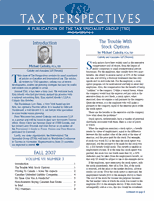
PDF Format
 Issue Contents Issue Contents
 All Issues All Issues
Fall 2007
Volume 7, Number 3
The information in Tax Perspectives is prepared for general interest only. Every effort has been made to ensure that the contents are accurate. However, professional advice should always be obtained before acting and TSG member firms cannot assume any liability for persons who act on the basis of information contained herein without professional advice.
Canadian Unlimited Liability Companies
By Hugh Woolley, CA
Lewis and Company (Vancouver)
While of little interest to Canadians, unlimited liability companies are of great interest to U.S. purchasers of Canadian companies.
Since 1900, corporate law in Nova Scotia has been modeled on the English style registration system and differs from Canadian corporate law in other provinces, which is entirely statute based. A Nova Scotia Unlimited Liability Corporation ("NSULC") is one of three types of corporations that can be created in that province (either with or without share capital).
In 1995, the U.S. Internal Revenue Service ruled that an NSULC is an "eligible entity" with the result that it will be treated as a partnership if it has more than one shareholder or a "disregarded entity" if it has only a single shareholder. However, under the "check-the-box" rules, an NSULC may elect to be treated as a corporation for U.S. purposes if so desired.
Thus, in cross-border tax planning, an unlimited liability corporation is a "hybrid entity" which presents significant Canada-U.S. tax planning opportunities. While, under Canadian law, an NSULC is considered a corporation for both corporate and tax purposes, for U.S. tax purposes, it is a "flow-through" entity. Accordingly for Canadian tax purposes, an NSULC is a stand alone entity, but for U.S. tax purposes all of the NSULC’s tax attributes, such as income, losses, interest expense and taxes payable, are considered to be those of the shareholder(s) of the NSULC.
Until recently, Nova Scotia was the only Canadian jurisdiction to allow these hybrid entities, so the NSULC became a cottage industry for Nova Scotia lawyers. Not wanting to be left out of the game, the mandarins in Alberta introduced similar legislation that was enacted in May 2005 and updated in December 2005.
Comparing an NSULC to an Alberta Unlimited Liability Corporation ("AULC") reveals some interesting differences.
Firstly, an NSULC is not required to have any Canadian directors, while at least 1/4 of the directors of an AULC must be Canadian resident.
Secondly, an NSULC has both an incorporation fee of $4,000 and a registration tax of $2,000, while the incorporation fee for an AULC is only $100. Also, an NSULC has an annual fee of $2,000 while there is no annual fee for an AULC.
Thirdly, migrating and converting a non-Alberta limited corporation into an AULC may be accomplished in a single step, whereas it is a multi-stage process for a non-Nova Scotia corporation to become an NSULC.
Fourthly, while an NSULC continues to be governed by antiquated law, AULC are governed by the Alberta Business Corporations Act, which is a modern statute. As such, mergers and other forms of corporate reorganizations tend to be simpler to undertake.
Finally, as the name implies, the debts and other obligations of unlimited liability companies can flow through to the shareholders. It is common for both Canadian and U.S. shareholders to insert a "blocker" corporation between the unlimited liability company and the ultimate shareholders. Although the shareholder of an NSULC is not directly liable to the creditors of the NSULC, both the past and present shareholders of an NSULC are responsible for any deficiency on the winding-up of an NSULC. Past and present shareholders of an AULC are jointly and severally liable for all liabilities of the company. However, a past shareholder of an NSULC who ceased to be a shareholder a year or more before the commencement of the winding-up has no liability. Although not initially part of the Alberta legislation, new rules provide that a former shareholder of an AULC is not liable for any amount unless the claim was commenced within two years from the date upon which the person ceased to be a shareholder of the AULC. Both an NSULC and AULC have rules that protect a former shareholder from liabilities that arose after they ceased to be a shareholder.
Generally, the tax planning opportunities that unlimited liability corporations ("ULC") present for U.S. investors in Canada include:
- The ability to claim start-up and on-going losses from Canadian operations without having to carry on business directly or through a partnership. As these losses continue to be "warehoused" in the ULC for Canadian tax purposes, they are available to offset future income in Canada. Subject to the acquisition of control rules, any losses carried forward would be available to a future owner of the corporation even though the U.S. shareholder has already claimed them in the U.S.
- Subject to certain limitations, U.S. shareholders of a ULC will be able to claim a direct foreign tax credit for any tax paid in Canada by the ULC. This is particularly valuable to individuals and trusts that hold shares of a Canadian ULC either directly or indirectly through an LLC or an S-corporation.
- Subject to the thin capitalization rules, a ULC can be used as a very efficient financing vehicle in connection with the acquisition of a Canadian target by a U.S. investor. This structure may be used in combination with an election to step up the tax cost of the assets of the Canadian target for U.S. tax purposes.
- A ULC can serve as a beneficiary of a Canadian trust.
- U.S. investors may use a ULC to own an interest in a partnership that desires to remain a Canadian partnership.
Do not be surprised if, in the course of selling a Canadian corporation, there is a flurry of activity to transform the corporation into a ULC. This is a tax-free reorganization in Canada to accommodate the tax planning objectives of the U.S. purchaser.
As a result of recent changes announced to the Canada-U.S. Treaty, to be effective in three years, it may be necessary to rethink some of the structures involving ULCs. We will be monitoring this with great interest.
| 






